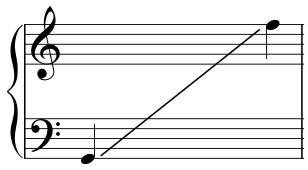Octave harmonics
Production
Harmonics are produced in two ways on the harp:
Right Hand
The string is stopped in its exact middle with the knuckle of the second or third finger and then played with the thumb. As the thumb plays the string, the knuckle leaves it, thus letting the string resonate.
Left Hand
The string is stopped at its exact middle with the side of the hand and then played with the thumb. As the thumb plays the string, the side of the hand leaves it, thus letting the string resonate.
The left hand can also produce harmonics in the same way as the right hand. This is especially useful when the left hand needs to play harmonics in the higher range.
Sound
Octave harmonics sound clear and are surprisingly loud. They usually carry well and are therefore audible through other instrumental textures. The sound is rich and warm in the middle range. In the high range harmonics become sharper and more percussive; in the low range they are softer and less clear. There is a considerable difference in color between harmonics produced on the wire strings and those produced on gut strings. In general gut string harmonics sound fuller and warmer.
Notation
An octave harmonic is notated by indicating the played string with a small circle above it. The resulting note sounds an octave higher than notated. This is the standard notation in contemporary harp literature. There is no need to indicate the sounding note, since a harpist will immediately know that an octave harmonic is meant.

Octave harmonics.
Range
The following range is comfortable for producing octave harmonics:

Optimal range for octave harmonics.
A good rule of thumb is to write octave harmonics only within the scope of the two staves. In this range the harmonics sound clear and precise. Octave harmonics written below the bass staff are possible but their sound becomes softer and less defined the lower the harmonics get. On the other hand, octave harmonics written above the treble staff are difficult to produce due to the short string length. Their sound is very percussive and dry.